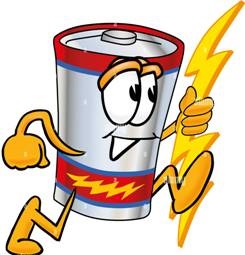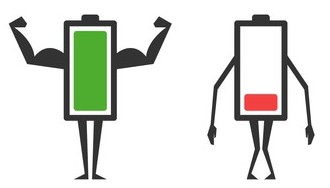 December 2021
December 2021
Is your laptop becoming useful only if it is plugged in?
When it was new it could go all day without recharging. Now it can barely make it for an hour. But all is not lost. Your beloved old portable pal may not be headed to the recycle site just yet.
With most laptops the battery can be easily removed and replaced. Did you know that stores like Batteries Plus sell replacement batteries for laptops? If you take the old battery, or better yet the whole laptop to a Batteries Plus store they can replace the old battery with a new one. In some cases, they may have to order it but for most of the common models they probably have one in stock. You can even recycle the old battery while you are there. (Please don’t just toss the old battery in the trash.)
Notebook computers, tablets phones and other devices suffer the same Li-ion problems as their laptop cousins. However, servicing the battery isn’t as easy. It can be dome but in most cases the unit has to be disassembled and that is not a simple task. Special tools and techniques are required. A lighted magnifier will probably be needed as well. Additionally, finding a battery may not be as easy as just going to Batteries Plus.

Lithium Ion, (Li-ion) batteries start to degrade from the time they are made even if they are not used. They have a fixed number of recharges. Whether you drain it completely and recharge it back to a full charge or just drain it down half way and recharge it twice that counts as one charge cycle. The more charge cycles the battery goes through the more it degrades. This degradation is not reversible.
Why is that?
Understanding why this happens will require a basic understanding of how Li-ion batteries work. Li-ion batteries, (like most batteries) depend on the movement of electrons between the electrodes. These electrodes are known as cathode and anode.
The cathode is made up of layers of a lithium rich material and the lithium ion sit between the layers. The anode is also a layered device made of a material, (like graphite) that accepts the lithium ions. The ions move from one electrode to another though a conductive medium known as electrolyte.
When the Li-ion battery is charging the ions move from the cathode to the anode through the electrolyte. This is the stored energy used to power the device. When the battery is providing power to the device the ions move from the anode and return to the cathode though the electrolyte. The capacity of the battery is the amount of energy it can provide to a device from this lithium ion shuttling.
There are a number of mechanical and chemical reactions that impede the performance of Li-ion batteries. The primary mechanisms such as structural disordering and particle fractures and the secondary mechanisms such as electrolyte decomposition and gas formation to name a few. These mechanisms combine to cause the loss of mobile ions in the battery reduces the battery’s ability to shuttle ions.
Battery life is also diminished when the electrode structure is damaged. Structural disordering and particle fractures occur during cycling as the ions move in and out of the electrodes. Island formation is when the material of the electrode is fractured and can leave parts of the electrode disconnected and unable to connect to the rest of the electrode. This reduces the number of ions that the electrodes can store and thus reduces the battery’s capacity.

Another reason is side reactions within the electrolyte that form compounds that “trap” the ions further reducing the number of mobile ions.
Research on ways to extend the life of Li-ion batteries continues. But for now, progress comes in small steps.
Battery temperature and lifespan.
A common misconception is that cold temperatures diminish the life of Li-ion batteries. While it is true that your phone will “die” more quickly in cold temperatures it does not diminish the life of the battery. What happens is the cold temperature causes the shuttling of ions between the electrode to occur more slowly. But when the battery warms up it functions normally with no lasting damage.
High temperatures do cause harm to Li-ion batteries. The electrolyte between the electrodes breaks down at higher temperature and the battery loses the ability to shuttle ions back and forth. This damage is not reversable.
OverchargingSome people believe that you shouldn’t leave your device plugged in once it is fully charged. While overcharging can lead to overheating and a possible fire hazard not to mention the reduction of the battery’s lifespan this is more myth than problem. Li-ion batteries have circuitry built into them to prevent overcharging. Once the battery is fully charged the electronic “watchdog” stops charging the battery even if the charger is still plugged in.
Most people never actually power down their phone, they just put it to “sleep” with the display turned off while charging. Since the device is still on and using electricity, the battery may discharge a little and then recharge again while on the charger. Eventually this can add up to a full cycle. The way to get around this is to power down your device before placing it on the charger.
What can you do about a weak battery?
Not much short of replacing it with a fresh new battery. There are web sites that proport to have ways to revive or regenerate your battery. They are a waste of time. I put them in the same class as the web sites that can make you rich, regrow your hair, help you lose weight and other click bait nonsense. The degradation of Li-ion batteries is not reversable.
Remember that Li-ion batteries start to decay from the time they are made. Try to get a replacement from someplace that sells a lot of batteries. You don’t want one that has been sitting on a shelf for a long time.

What can you do to extend the life of your device’s Li-ion battery? In the real world, not very much. Here are some of the commonly parroted battery saving tips offered up from a Google search.
- Turn down the brightness.
- Oh, that is just great! You get the new phone with the ultra-high-performance display and you are going to dim it down to the point that it is only viewable in total darkness.
- Turn off some apps
- Some of the more power-hungry apps like games or streaming are very graphics and audio intensive. So, no streaming or gaming allowed. Remind me again why you bought this device.
- Turn off the Wi-Fi connection
- While the Wi-Fi radio does use a lot of power this means you are using up your minutes or you are just offline with no Internet access. See comment from previous energy saving tip.
- Turn on the Airplane Mode.
- While you may have to do this when flying on a commercial airliner it means that you will not be able to make or receive calls, text messages or connect to the Internet. You might as well be carrying a brick around in your pocket.
- Turn off the location service
- The location service uses GPS to pinpoint your location. Not only does it provide navigation in unfamiliar places but it can provide valuable information to first responders in an emergency.
While some very educated people may have thought up these tips in a real-life scenario they just don’t work. I recommend a different approach like using portable chargers. I have several home chargers, car chargers and a travel charger so, most anywhere I am at I can charge my devices.
As a side note, this newsletter focuses mainly on the life span of Li-ion batteries in electronic devices. However, the same is true for the Li-ion batteries used in automotive applications. But instead of replacing a relatively small battery to restore performance you may have to replace several tons of batteries to restore the performance in your EV. You will have to contact the manufacture for specific service information. The local Batteries Plus store probably won’t have what you need.
And remember — always back it up!